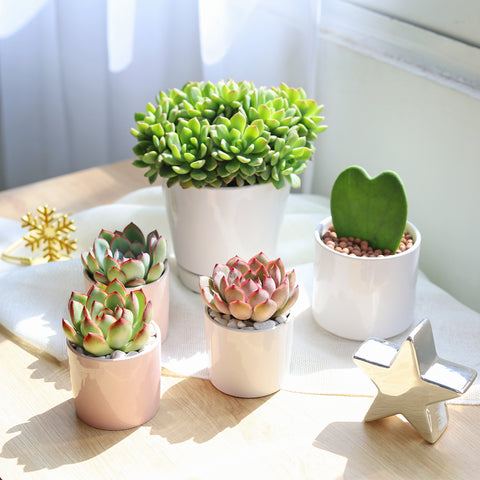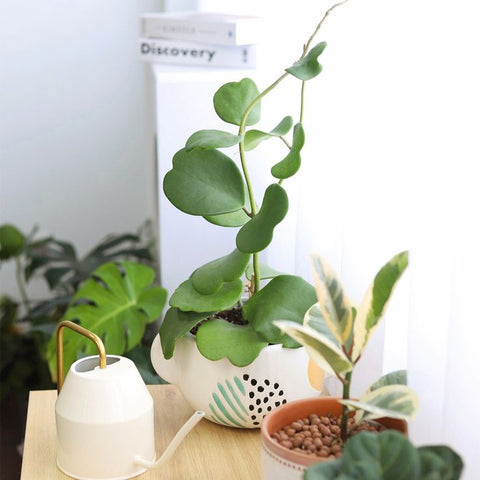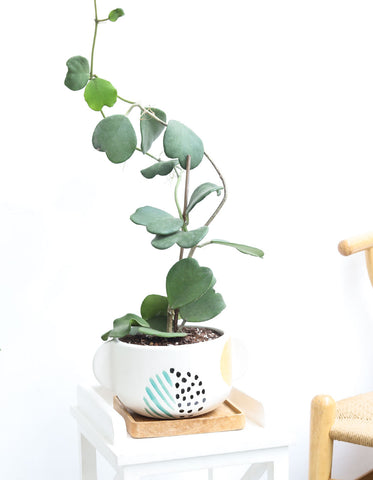Hoya Kerrii, commonly known as the Sweetheart Hoya or Valentine Hoya, is native to Southeast Asia, particularly in Thailand and parts of China. This plant belongs to the Apocynaceae family. Its heart-shaped leaves have contributed to its association with love, making it a popular choice as a symbol of affection. The plant has been cultivated for many years, gaining widespread popularity for its unique leaf shape and the sentiment it carries, and is often chosen as a gift for special occasions such as Valentine's Day and anniversaries.
The most distinctive feature of Hoya kerrii is its thick, heart-shaped succulent leaves. The leaves can vary in size, and the plant may produce trailing vines as it matures. The glossy, deep green leaves contribute to its charm, making it a visually appealing addition to any indoor space.
The specific epithet "kerrii" is derived from the name of the Irish horticulturist Arthur Francis George Kerr, who worked extensively in Southeast Asia in the early 20th century. The plant was named in his honor for his contributions to botany and horticulture in the region.
Hoya kerrii is considered an easy-care plant, making it suitable for individuals with varying levels of gardening experience. Its ability to adapt to different indoor environments adds to its appeal as a hassle-free gift.
Hoya Kerrii Heart Cultivation
Hoya Kerrii is available in two popular forms. It can be sold as a traditional plant with stems and multiple leaves, creating a lush and full appearance. This version of Hoya kerrii showcases a cluster of heart-shaped leaves on a cascading stem, providing a beautiful and decorative look.
Alternatively, Hoya kerrii can also be sold as a single-leaf plant, where a solitary heart-shaped leaf is presented on its own. This single leaf is often larger and more pronounced, resembling a green heart. This form has gained popularity as a symbolic and lasting gift, especially during special occasions like Valentine's Day, where the heart-shaped leaf becomes a meaningful representation of enduring love and care. Both variations of Hoya kerrii are equally enchanting, and the choice between them depends on personal preference and the intended significance of the plant.
Special Characteristics of Hoya Kerrii
Leaf Structure
Hoya kerrii is cherished for its distinctive heart-shaped leaves. There are very few plants that can compete with Hoya kerrii in making such perfect hearts! These vibrant green leaves have become a symbol of love and affection in the houseplant world. Hoya leaves are thick, fleshy, and very succulent-like. Each leaf is a solitary, unique heart. It earns and owns the title "Sweetheart Hoya" with its impeccably heart-shaped leaves!
Growth Habit
Hoya kerrii is epiphytic, meaning it can grow on other surfaces like trees in its native tropical environments. This adaptation allows the plant to absorb nutrients and moisture from the air and rain, making it well-suited for various indoor conditions. While it can be grown in soil, it thrives in environments that mimic its epiphytic habitat. Hoya kerrii, like many other Hoyas, is known for producing aerial roots. These roots emerge from the stems and have multiple functions, including attaching the plant to its substrate and aiding in water absorption. While Hoya kerrii is not as reliant on aerial roots as some climbing Hoyas, the presence of these roots adds to the plant's unique appearance.
The stems of Hoya kerrii are typically viningand can grow to be quite long with proper care. The plant has a trailing or cascading growth habit, making it an ideal candidate for hanging baskets or elevated planters. Its vining nature allows it to gracefully drape over the edges of containers, creating a charming and eye-catching display.

Blooming
While Hoya kerrii is adored for its heart-shaped leaves, it is not as well-known for its flowers as some other members of the Hoya genus. The blooms of Hoya kerrii are small and star-shaped, arranged in clusters known as umbels. The flowers can be creamy white or pinkish and emit a sweet fragrance, adding a delightful sensory element to the plant.
Toxicity
Hoyas, including Hoya kerrii, are some of the best pet-friendly houseplants. While it is not known to be toxic, it is wise to exercise caution by placing it out of reach, particularly in households with inquisitive pets or small children. This precaution ensures not only the safety of your loved ones but also helps maintain the plant's health and aesthetic appeal.
As with any plant, individual sensitivities can vary, so if there are specific concerns or if someone in your household has known allergies, seeking advice from a healthcare professional or veterinarian is a prudent measure to ensure a safe environment.
General Care
Lighting
Hoya Kerrii Heart prefers bright, indirect light. Too much direct sunlight can scorch the leaves, while low light will cause them to lose their vibrant color. A good rule of thumb is to place your Hoya Kerrii Heart in a spot that receives filtered light from a north-facing window. One practical aspect of the Sweetheart Hoya's lighting requirements is its adaptability to various locations within your home. It can thrive on shelves, hanging baskets, or placed on tables where it can receive filtered sunlight. This versatility allows plant enthusiasts to incorporate the Sweetheart Hoya into different areas, adding a touch of greenery and charm to various corners of their living spaces. If your home has very little lighting, especially during the dark cold months, you can also use a grow light to supplement the natural light if needed.
If you're not sure how much light your Hoya Kerrii Heart is getting, you can check the color of the leaves. If the leaves are a healthy green color, the plant is getting enough light. If the leaves are starting to turn yellow or brown, the plant is not getting enough light. You can move the plant to a brighter spot or increase the amount of time it receives filtered sunlight. Don’t forget to rotate the pot so all sides of your plant receive enough lighting.

You can move the plant to a brighter spot or increase the amount of time it receives filtered sunlight.
Remember that while Hoya kerrii can tolerate lower light levels than some other Hoyas, providing optimal lighting conditions will result in a more vigorous and attractive plant.
Watering
Sweetheart Hoya has relatively moderate watering needs, as it can store water in the chubby leaves. It's important to allow the top inch or two of the soil to dry out between watering sessions. This helps prevent overwatering, a common issue that can lead to root rot. When watering, ensure that you provide enough water to thoroughly moisten the soil without letting the plant sit in standing water. Allow excess water to drain away, and avoid leaving the plant in a saucer filled with water. This Hoya is more forgiving of underwatering than overwatering, so it's better to err on the side of slightly drier soil.
As with many succulent and semi-succulent plants, adjusting the watering frequency based on the environmental conditions of your home is crucial. Factors such as room temperature, humidity levels, and the size of the pot can influence the plant's water needs. Regularly check the soil moisture and adapt your watering routine accordingly to promote a healthy and thriving Sweetheart Hoya. Underwatering will cause the leaves to wilt and droop while overwatering will cause the leaves to turn yellow or brown.

This Hoya is more forgiving of underwatering than overwatering, it's better to err on the side of slightly drier soil.
Soil and Fertilizer
Sweetheart Hoya, like many succulent plants, benefits from well-draining soil to prevent waterlogging and promote root health. A suitable potting mix for Hoya kerrii includes a blend of cactus or succulent mix, perlite, and coarse sand. This mixture allows for adequate drainage, preventing the roots from sitting in water for extended periods.
Regarding fertilization, Hoya kerrii has modest nutritional requirements. During the growing season in spring and summer, you can provide a balanced, water-soluble fertilizer formulated for succulents and cacti. Dilute the fertilizer to half the recommended strength, and apply it every two to four weeks. Remember to follow the recommended guidelines for the specific fertilizer you choose, and avoid over-fertilizing, as this can lead to nutrient imbalances and potential harm to the plant. After fertilizing, flush the soil with water to remove any excess fertilizer. Stop fertilization during the fall and winter, as the plant enters a period of dormancy with reduced growth.
Temperature and Humidity
Hoya kerrii prefers a warm and stable environment, typically thriving in temperatures between 60°F to 75°F. t can tolerate temperatures as low as 50°F, but it is not frost tolerant. Avoid exposing the plant to sudden temperature fluctuations, drafts, or extreme heat, as these conditions can stress the plant.
As for humidity, Hoya kerrii is relatively adaptable. It can tolerate average household humidity levels, which typically range from 30% to 60%. However, it is not a humidity-loving plant and can survive in drier conditions. If you live in a very dry climate, you may want to mist the leaves of your Hoya kerrii occasionally or place the pot on a pebble tray filled with pebbles and water to help with humidity. Additionally, grouping plants together can create a microclimate with slightly elevated humidity. Don’t forget that high humidity can lead to problems such as mold growth or pest infestations. Ensure good air circulation around your plant to prevent these issues.
Potting And Repotting
For potting, choose a well-draining pot with drainage holes to prevent waterlogging. For a single-leaf Hoya kerrii, a smaller pot is suitable, while a larger pot is needed for a plant with multiple leaves. The best materials for porous, drainage-optimized pots are cement, ceramic, and terracotta.
During repotting, which typically occurs every 1-2 years, delicately remove the plant, ensuring minimal harm to the roots. For a single-leaf Hoya kerrii, transplant it once the leaf has developed roots. Inspect the roots for any signs of damage or disease, trim away unhealthy parts, and move the plant into a slightly larger pot with fresh, well-draining soil. Water the plant sparingly after repotting to reduce stress, contributing to the overall health and vitality of the Hoya kerrii, be it a single leaf or a multi-leaf specimen. Repotting is recommended during the growing season and only when you see signs that your plant has outgrown its current container, such as roots circling the bottom of the pot or poking through drainage holes.
Pruning
Hoya kerrii plant with multiple leaves and stems needs minimal pruning. You may prune your Hoya kerrii if you notice dead or dying leaves, if it becomes too leggy due to insufficient light, or if you want to encourage a bushier growth habit. Pruning can also help maintain the plant's shape and size within your desired space. Always use clean, sharp scissors or pruning shears and make cuts at an angle to allow water runoff and prevent disease. The best time to prune your Hoya kerrii is during the spring or early summer, which is the beginning of its active growing season. This timing allows the plant to recover quickly and use the energy from brighter days for new growth. After pruning, avoid watering your plant immediately; give it a few days for the cuts to callus over before resuming watering. This helps prevent rot and infection at the cut sites.

Propagation
Propagating Hoya kerrii can be done with stem cutting. You can start with selecting a healthy stem with at least one or two leaves, ensuring there are a few inches of stem below the leaves. Use clean, sharp scissors or pruning shears to make a clean cut just below a leaf node, where a leaf meets the stem. Allow the cutting to air dry in a shaded area for a day or two, letting the cut end form a callus to prevent rot. Once the cutting has callused, plant it in a well-draining potting mix, burying the cut end about an inch into the soil. Water the soil lightly, maintaining consistent moisture without overwatering. Place the pot in an area with bright, indirect light, avoiding direct sunlight. After a few weeks, check for resistance by gently tugging on the cutting to see if roots have formed. Once well-established roots are evident, transplant the cutting into a larger container or its permanent growing location. Keep in mind that success may vary, so taking multiple cuttings can enhance the chances of successful propagation.
Can you propagate a single-leaf Hoya kerrii?
Unfortunately, it is not possible to make more baby kerrii from a single-leaf Hoya. Even though the leaf grow roots, it doesn't transform into a fully developed plant, so it will not develop new stems or leaves. To propagate, a cutting with at least one node is needed.
Common Problems
Hoya kerri is generally a resilient and low-maintenance plant, but like any houseplant, it can face a few common issues. One potential problem is overwatering, which may lead to root rot. It's crucial to allow the top inch of soil to dry before watering and ensure proper drainage in the pot.
Insufficient light can also pose a challenge, resulting in leggy growth or a lack of flowering. While Sweetheart Hoyas can tolerate some low light, it still thrives best in bright, indirect light. Placing your plant near a window with filtered sunlight is ideal.
Pestslike aphids, mealybugs, or spider mites might occasionally infest Hoya kerrii. Regularly inspecting the plant, especially the undersides of leaves, and using insecticidal soap or a gentle wipe with a damp cloth can help control these pests.
Moreover, extreme temperature fluctuations can stress the plant, causing leaf drop or yellowing leaves. This Hoya needs consistent temperatures between 60°F - 75°F. Avoid exposing them to drafts, sudden temperature changes, or extreme conditions.
































































































